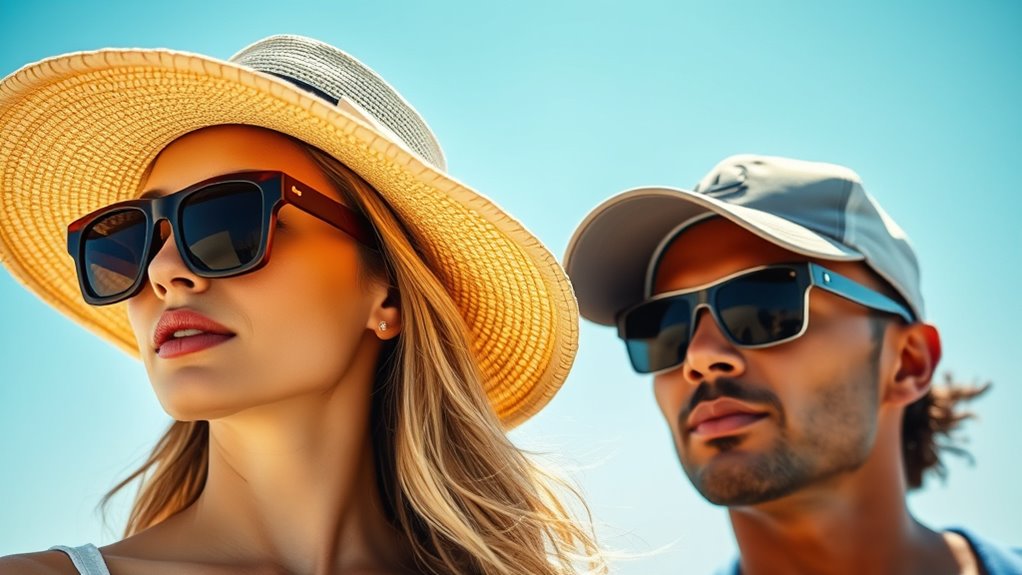Hats and sunglasses play a vital role in protecting your skin and eyes from harmful UV rays. Wide-brimmed hats shield your face, neck, and ears, while UV-protective sunglasses block UVA and UVB rays around your eyes, reducing risks like sunburns, cataracts, and skin cancers. Combining these accessories creates a strong, layered defense against sun damage. To learn how to choose the best options and maximize your protection, keep exploring these essential sun safety tools.
Key Takeaways
- Hats with wide brims provide extensive coverage for the face, neck, and ears, reducing UV exposure in these vulnerable areas.
- UV-protective sunglasses block UVA and UVB rays, protecting the eyes and surrounding skin from damage and cataracts.
- Physical barriers like hats and sunglasses complement sunscreen, especially for areas often missed by topical protection.
- Proper fit and design features, such as wraparound frames and wide brims, enhance the effectiveness of sun protection accessories.
- Consistent use of hats and sunglasses during outdoor activities significantly lowers the risk of skin and eye damage from UV rays.
Importance of Hats in Shielding Your Skin From UV Rays
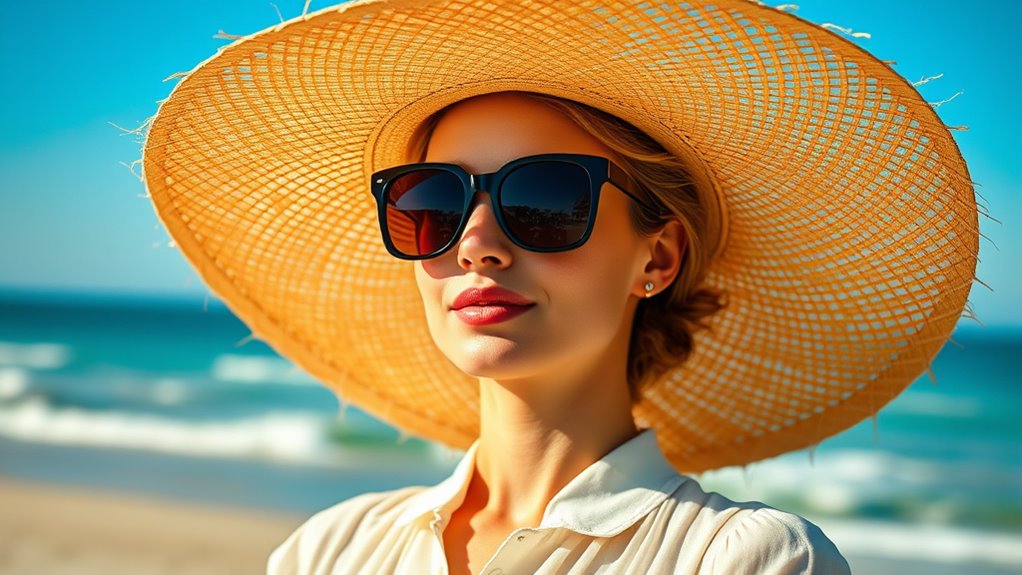
Wearing hats is one of the most effective ways to protect your skin from harmful UV rays. Hats help reduce your risk of skin cancer by shielding your face, neck, and ears from direct sunlight. They provide broader protection than sunscreen alone since they cover large areas without needing reapplication. Hats with high UPF ratings block a significant percentage of UV rays, enhancing your safety outdoors. The material and weave density matter—tighter weaves and UPF-certified fabrics offer better protection. Wide-brimmed styles are especially effective at covering vulnerable areas like the ears and neck, reducing the chances of sunburn and actinic keratoses. When combined with other sun protection methods, hats form an essential barrier against UV damage, especially during peak sun hours and prolonged exposure. Additionally, choosing sun-protective clothing can further improve your overall defense against UV radiation during outdoor activities.
Types of Sun-Protection Hats and Their Benefits
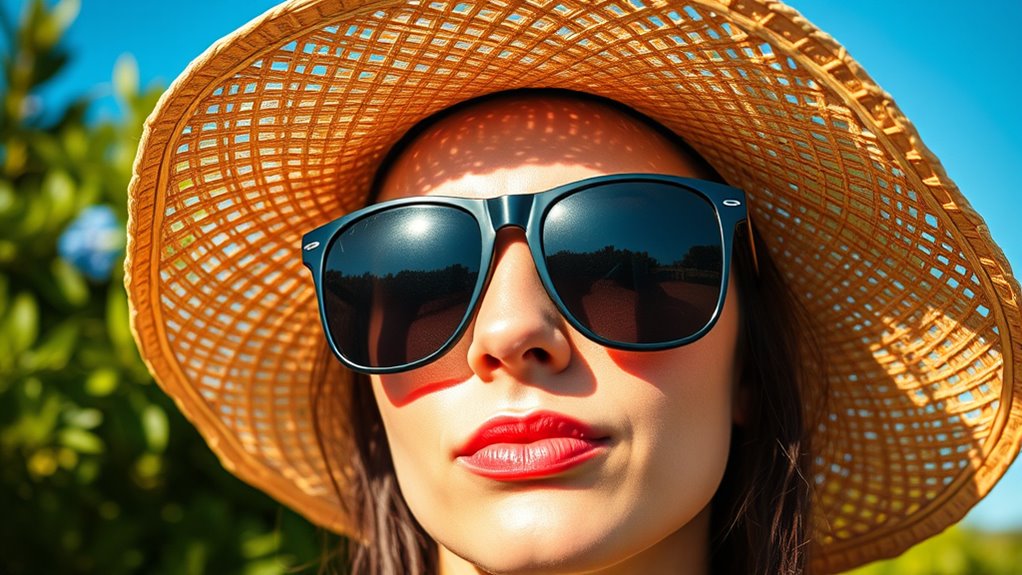
Choosing the right type of sun-protection hat can significantly enhance your outdoor safety, as each style offers unique benefits suited to different activities and needs. Bucket hats provide moderate sun protection with a small to medium brim, perfect for casual outings. Wide-brim hats offer comprehensive coverage for the face and neck, making them ideal for gardening or hiking. Legionnaires hats feature a neck cape for extra protection, especially useful during golf or travel. Fedora hats combine style with UPF 50+ protection, suitable for casual wear. Baseball caps offer limited coverage but are popular for daily activities. Materials like cotton, straw, and polyester ensure durability and breathability. Selecting the right hat helps prevent skin cancer, shields against UV rays, and suits your activity, style, and comfort needs. Additionally, choosing hats made from natural materials can enhance comfort and authenticity, aligning with rustic decor themes often seen in farmhouse-inspired outdoor accessories. Proper fit and UV protection features are essential to maximize the benefits of your sun-protection hat and ensure comfort during prolonged outdoor exposure. Ensuring your hat provides adequate shade coverage can further improve your sun safety during outdoor activities. Incorporating hats with built-in UPF ratings can also offer additional assurance of effective UV protection. When selecting a hat, consider the sun protection factor it provides to ensure optimal safety.
How Sunglasses Help Protect Your Eyes From UV Damage
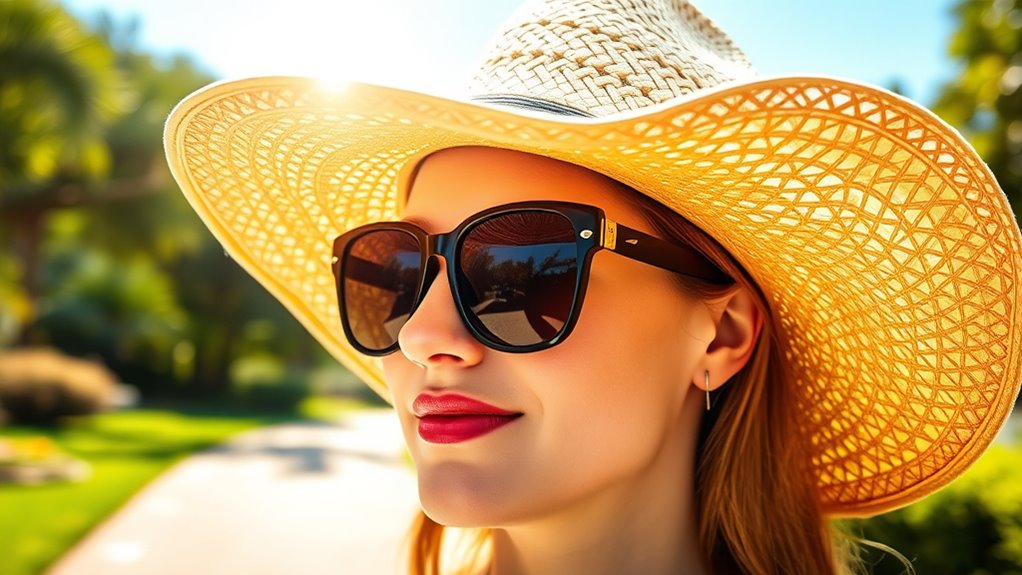
Sunglasses play a crucial role in protecting your eyes from harmful UV rays, which can cause serious damage over time. To do this effectively, your sunglasses need to provide 100% UV protection, often labeled as “UV400,” blocking both UVA and UVB rays. UVA rays can damage your retina, while UVB rays can cause eye sunburn or photokeratitis and contribute to cataracts. Look for sunglasses with labels that confirm full UV protection, and ensure the lenses are polarized or tinted for added glare reduction. A proper fit is essential to prevent UV rays from entering around the edges. Regularly wearing sunglasses with these features helps minimize the risk of eye conditions like cataracts and macular degeneration, safeguarding your eye health during outdoor activities. Additionally, choosing sunglasses with adequate coverage can further enhance protection from direct and peripheral UV exposure. The use of properly designed sunglasses with high-quality lenses is also recommended to maximize UV defense and reduce eye strain. Incorporating appropriate eye protection into your daily routine is an effective way to maintain overall eye health and vision clarity. Ensuring your sunglasses meet established safety standards can provide additional peace of mind and reliable protection. Recognizing the importance of UV protection in outdoor gear underscores the connection between outdoor safety and preventative health measures.
Combining Hats and Sunglasses for Complete Sun Safety
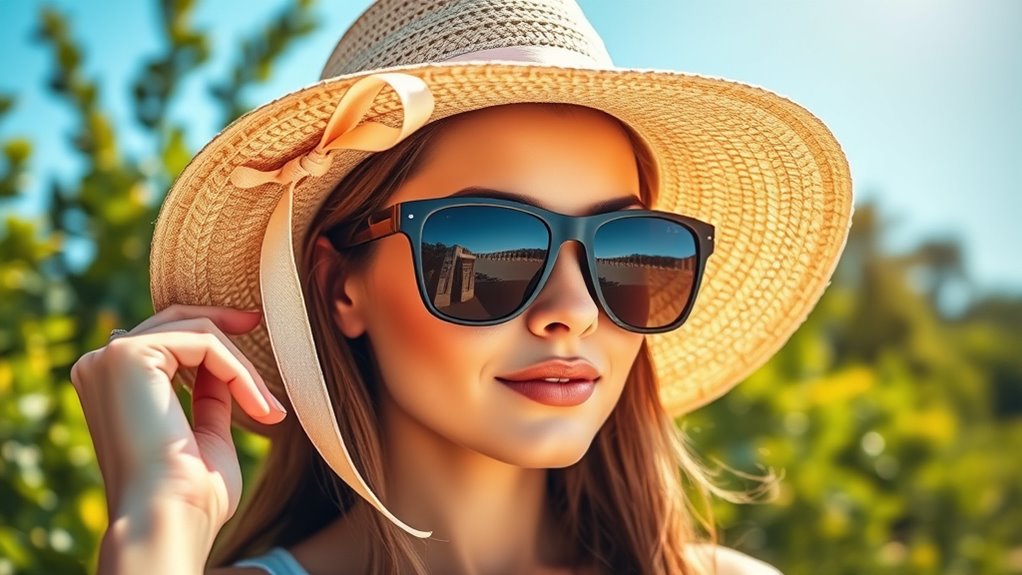
Combining hats and sunglasses offers an extensive approach to sun safety, markedly reducing UV exposure and protecting your skin and eyes. A wide-brimmed hat can block UV rays from reaching your face, ears, and neck, especially when it has a high UPF rating. Sunglasses with 100% UV protection shield your eyes from harmful rays and glare, preventing long-term damage. Together, these accessories provide broader coverage than using either alone, particularly during peak hours from 10 a.m. to 4 p.m. Layering clothing under hats and sunglasses further diminishes direct sun exposure. This combination not only safeguards your skin and eyes but also reduces light intensity, making outdoor activities more comfortable. Using hats and sunglasses together creates a comprehensive, effective sun protection strategy for outdoor enjoyment. Understanding UV protection is essential for selecting the right accessories and maximizing sun safety.
Factors That Influence the Effectiveness of Sun-Protection Accessories
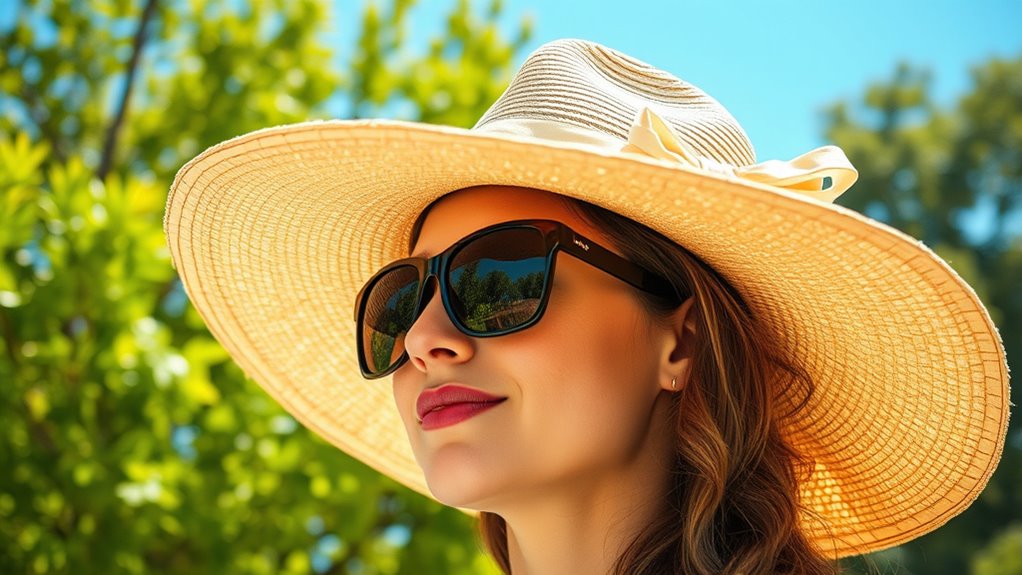
The effectiveness of sun-protection accessories depends on several key factors that influence how well they shield you from harmful UV rays. Material composition plays a crucial role—tightly woven fabrics and UV-blocking coatings on sunglasses improve protection, while synthetic materials like nylon or polyester often offer higher UV resistance than natural fibers. Design features, such as a wide brim (3+ inches) and wraparound frames, enhance facial coverage and minimize UV exposure. Proper fit matters too; adjustable headbands and snug sunglasses prevent gaps that let sunlight in. Environmental conditions, like high UV index, reflective surfaces, and cloud cover, can increase UV exposure, demanding more effective accessories. Your consistent use, correct positioning, and timely replacement are essential to maximize protection.
Tips for Selecting the Most Protective Hats and Sunglasses

Choosing the most protective hats and sunglasses requires careful attention to specific features that maximize UV defense. Pick UPF-rated hats with UPF 50+ to block 98% of UV rays, and look for full-brim designs of 3 inches or more for thorough face, neck, and ear coverage. Confirm hats have dense, tightly woven fabrics without gaps, and consider models with extended back flaps for extra neck protection. For sunglasses, select pairs labeled UV400 or with 100% UV protection, featuring wraparound frames to limit peripheral exposure. Larger lenses that cover from eyebrows to cheekbones enhance protection, and polycarbonate lenses offer impact resistance along with UV filtration. Adjustability, ventilation, and secure fit are key to comfort and consistent coverage during prolonged wear. Additionally, choosing water-resistant materials can help keep your gear effective even in humid or wet conditions. Ensuring your accessories have proper coverage is essential to effectively shield your skin and eyes from harmful UV radiation. Incorporating UV protective features into your sun gear is an effective way to maximize your sun safety efforts. Notably, many innovative materials now incorporate sustainable options, aligning protection with eco-conscious choices.
Enhancing Sun Safety With a Holistic Approach to Skin and Eye Care
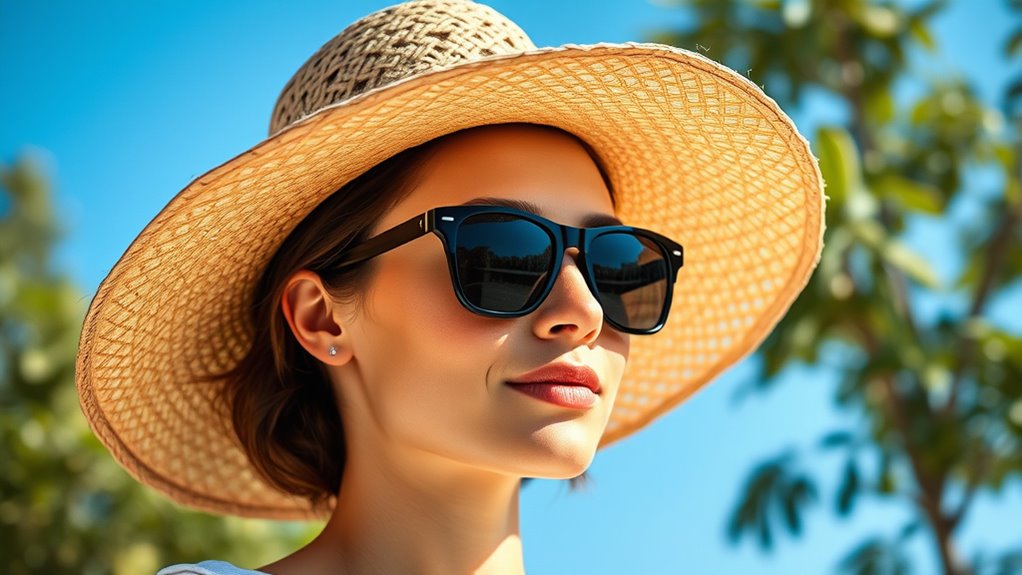
To effectively protect your skin and eyes from harmful UV rays, adopting a thorough approach that integrates physical barriers like hats and sunglasses with other protective strategies is essential. Wearing wide-brimmed hats and UV-protective sunglasses reduces exposure to areas often missed by sunscreen, lowering skin cancer and eye damage risks. Combine these with daily use of broad-spectrum sunscreen and protective clothing for layered defense. Remember, sun safety isn’t seasonal—consistent habits matter year-round. Supporting physical barriers with dietary antioxidants, like vitamins C and E, can further strengthen your skin’s resilience. Limiting sun exposure during peak hours and adjusting protection to your environment and skin type optimize results. Additionally, understanding the importance of contrast ratio and how it impacts image quality can inspire you to choose the right protective gear that minimizes glare and enhances visual clarity. Being aware of regulatory frameworks and staying informed about new standards can help you make safer choices in sun protection. For example, wearing appropriate eyewear can significantly reduce UV exposure to your eyes. Incorporating UV-protective materials into your clothing choices adds an extra layer of defense against sun damage. Research suggests that specialized fabrics can provide even greater protection from UV rays, making them a smart addition to your sun safety arsenal. By integrating these practices, you build a comprehensive shield that safeguards your long-term skin and eye health.
Frequently Asked Questions
Can Hats and Sunglasses Completely Block UV Rays?
You wonder if hats and sunglasses can completely block UV rays. While they markedly reduce exposure, neither offers total protection on their own. Wide-brimmed hats with high UPF ratings shield your face, neck, and shoulders, and UV-blocking sunglasses protect your eyes. When used together, they provide a strong defense, but for full coverage, combine them with other measures like sunscreen and seeking shade.
Do Uv-Protective Hats Need Special Materials?
You ask if UV-protective hats need special materials. Yes, to provide effective UV protection, they often use tightly woven synthetics like polyester or nylon, which block most UV rays naturally. Some may include UPF 50+ certification, ensuring high UV blockage. While natural materials like cotton or straw can work if tightly woven, they generally offer lower protection without special treatments. Look for hats with specific UV-fighting fabrics or certifications for reliable sun safety.
How Often Should I Replace Sun-Protection Sunglasses?
Ever wonder how long your sunglasses really protect your eyes? You should replace your sun-protection sunglasses roughly every two years, especially if you wear them daily or in high UV environments. Over time, coatings wear down, lenses scratch, and frames become brittle. Regularly inspect your sunglasses and replace them sooner if you notice scratches or coating degradation. Proper maintenance guarantees you get the full UV protection and keep your eyes safe.
Are There Specific Hat Styles Best for Sensitive Skin?
When choosing hats for sensitive skin, go for wide-brimmed styles like sun hats or bucket hats with UPF 50+ ratings. Look for soft, natural fabrics such as cotton or bamboo that won’t irritate your skin. make certain the hat has a snug fit with adjustable straps, soft lining, and full coverage of your face, ears, and neck. Avoid synthetic or loosely woven fabrics to prevent overheating and irritation.
Can Reflective Surfaces Like Water Increase UV Exposure Even With Hats and Sunglasses?
Ever wonder if water can secretly boost your UV risk even when you wear hats and sunglasses? The answer is yes. Reflective surfaces like water, snow, and sand bounce UV rays right back at you, increasing your exposure. Even with your protective gear, you might still face harm from these reflected rays. That’s why combining protective clothing, sunscreen, and seeking shade is essential, especially near reflective surfaces.
Conclusion
Wearing hats and sunglasses can cut your UV exposure by up to 50%, markedly lowering your risk of skin and eye damage. With over 1 million cases of skin cancer diagnosed annually, taking sun protection seriously is essential. By choosing the right hats and sunglasses, you’re actively reducing harmful rays reaching your skin and eyes. Make these accessories your daily sun safety allies—because protecting yourself now can save your health in the future.
